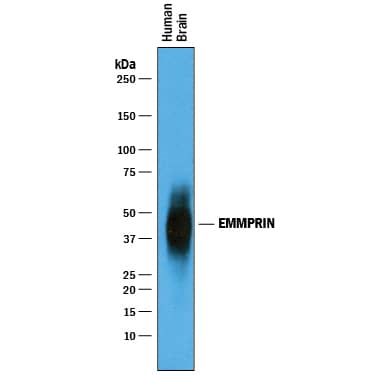Human EMMPRIN/CD147 Antibody
R&D Systems, part of Bio-Techne | Catalog # AF972


Key Product Details
Validated by
Species Reactivity
Validated:
Cited:
Applications
Validated:
Cited:
Label
Antibody Source
Product Specifications
Immunogen
Thr25-His205
Accession # Q54A51
Specificity
Clonality
Host
Isotype
Scientific Data Images for Human EMMPRIN/CD147 Antibody
Detection of Human EMMPRIN/CD147 by Western Blot.
Western blot shows lysates of human brain tissue. PVDF membrane was probed with 1 µg/mL of Goat Anti-Human EMMPRIN/CD147 Antigen Affinity-purified Polyclonal Antibody (Catalog # AF972) followed by HRP-conjugated Anti-Goat IgG Secondary Antibody (Catalog # HAF019). A specific band was detected for EMMPRIN/CD147 at approximately 38-50 kDa (as indicated). This experiment was conducted under reducing conditions and using Immunoblot Buffer Group 1.EMMPRIN/CD147 in Human Stomach Cancer Tissue.
EMMPRIN/CD147 was detected in immersion fixed paraffin-embedded sections of human stomach cancer tissue using Goat Anti-Human EMMPRIN/ CD147 Antigen Affinity-purified Polyclonal Antibody (Catalog # AF972) at 5 µg/mL overnight at 4 °C. Tissue was stained using the Anti-Goat HRP-DAB Cell & Tissue Staining Kit (brown; Catalog # CTS008) and counterstained with hematoxylin (blue). Specific labeling was localized to the plasma membrane of epithelial cells. View our protocol for Chromogenic IHC Staining of Paraffin-embedded Tissue Sections.EMMPRIN/CD147 in Human Cervix.
EMMPRIN/CD147 was detected in immersion fixed paraffin-embedded sections of human cervix using Goat Anti-Human EMMPRIN/CD147 Antigen Affinity-purified Polyclonal Antibody (Catalog # AF972) at 1 µg/mL overnight at 4 °C. Tissue was stained using the Anti-Goat HRP-DAB Cell & Tissue Staining Kit (brown; Catalog # CTS008) and counterstained with hematoxylin (blue). Specific staining was localized to plasma membranes. View our protocol for Chromogenic IHC Staining of Paraffin-embedded Tissue Sections.Applications for Human EMMPRIN/CD147 Antibody
ELISA
This antibody functions as an ELISA detection antibody when paired with Mouse Anti-Human EMMPRIN/CD147 Monoclonal Antibody (Catalog # MAB972).
This product is intended for assay development on various assay platforms requiring antibody pairs. We recommend the Human EMMPRIN/CD147 DuoSet ELISA Kit (Catalog # DY972) for convenient development of a sandwich ELISA or the Human EMMPRIN/CD147 Quantikine ELISA Kit (Catalog # DEMP00) for a complete optimized ELISA.
Immunohistochemistry
Sample: Immersion fixed paraffin-embedded sections of human breast, gastric, lung, stomach, pancreatic cancer tissue, and cervix
Knockout Validated
Simple Western
Sample: Human brain (cerebellum) tissue
Western Blot
Sample: Human brain tissue
Reviewed Applications
Read 1 review rated 4 using AF972 in the following applications:
Formulation, Preparation, and Storage
Purification
Reconstitution
Formulation
Shipping
Stability & Storage
- 12 months from date of receipt, -20 to -70 °C as supplied.
- 1 month, 2 to 8 °C under sterile conditions after reconstitution.
- 6 months, -20 to -70 °C under sterile conditions after reconstitution.
Background: EMMPRIN/CD147
EMMPRIN is expressed in areas of tissue remodeling, including tumors, endometrium, placenta, skin, and regions undergoing angiogenesis (1, 2, 6-9). It is also expressed in cells with high metabolic activity, such as lymphoblasts, macrophages and tumor cells (2, 10). On cells with elevated metabolic rates, EMMPRIN is often co-expressed with the amino acid transporter CD98h (11). EMMPRIN also interacts with caveolin-1 (via its C2-like domain), and this reduces the level of EMMPRIN glycosylation and subsequent EMMPRIN multimerization and activity (12). EMMPRIN’s TM sequence contains a Glu and a Pro which are important for intracellular interactions with cyclophilins (CyP) (3, 13, 14). CyPA (cyclosporin A receptor) and CyP60 interactions with the TM segment promote leukocyte inflammatory chemotaxis and surface expression of EMMPRIN, respectively (13, 14). An active 22 kDa fragment can be shed from tumor cells by MT1-MMP (1). Tumor cells can also release active, full-length EMMPRIN in microvesicles (15, 16). Functionally, EMMPRIN is known to induce urokinase-type plasminogen activator (uPA), VEGF, hyaluronan, and multiple MMPs (1, 2, 7, 8, 9). Human EMMPRIN (269 aa) shows 58%, 58%, 62%, and 52% aa identity with mouse, rat, bovine, and chicken EMMPRIN, respectively. It also shows 25% and 38% aa identity with the related proteins, embigin and neuroplastin (SDR-1), respectively (4).
References
- Gabison, E.E. et al. (2005) Biochimie 87:361.
- Yurchenko, V. et al. (2006) Immunology 117:301.
- Kasinrerk, W. et al. (1992) J. Immunol. 149:847.
- Miyauchi, T. et al. (1991) J. Biochem. 110:770.
- Hanna, S.M. et al. (2003) BMC Biochem. 4:17.
- Riethdorf, S. et al. (2006) Int. J. Cancer 119:1800.
- Braundmeier, A.G. et al. (2006) J. Clin. Endocrinol. Metab. 91:2358.
- Tang, Y. et al. (2006) Mol. Cancer Res. 4:371.
- Quemener, C. et al. (2007) Cancer Res. 67:9.
- Wilson, M.C. et al. (2005) J. Biol. Chem. 280:27213.
- Xu, D. and M.E. Hemler (2005) Mol. Cell. Proteomics 4:1061.
- Tang, W. et al. (2004) Mol. Biol. Cell 15:4043.
- Arora, K. et al. (2005) J. Immunol. 175:517.
- Pushkarsky, T. et al. (2005) J. Biol. Chem. 280:27866.
- Egawa, N. et al. (2006) J. Biol. Chem. 281:37576.
- Sidhu, S.S. et al. (2004) Oncogene 23:956.
Long Name
Alternate Names
Gene Symbol
UniProt
Additional EMMPRIN/CD147 Products
Product Documents for Human EMMPRIN/CD147 Antibody
Product Specific Notices for Human EMMPRIN/CD147 Antibody
For research use only




